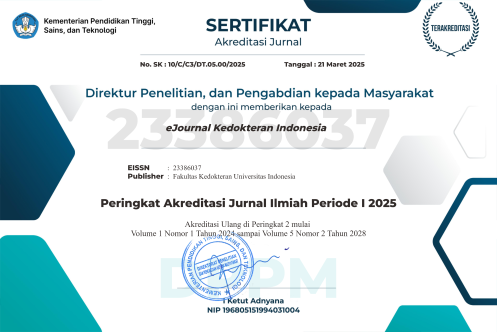The Development of Causative Patterns of Cleft Lip and Palate in Eastern Indonesia
DOI:
https://doi.org/10.23886/ejki.13.1123.1Keywords:
CL/P, Eastern Indonesia, economy, genetics, socialAbstract
Cleft lip or cleft palate (CL/P) is a congenital disorder involving genetic and environmental factors. Eastern Indonesia is a region with the fourth-highest incidence of CL/P in Indonesia. Low socioeconomic conditions in this region are thought to contribute to the high prevalence of CL/P, both directly and through maternal health and environmental factors. This study aims to identify and analyze the evolving patterns of causative factors for cleft lip and/or palate (CL/P) in Eastern Indonesia. Conducted between February and October 2024, the research employs a cross-sectional design integrated with a path analysis approach to explore the complex interplay between environmental exposures and genetic predispositions contributing to CL/P in the region. Purposive sampling was used to interview families of CL/P patients to gather samples; the number of respondents was chosen based on the predetermined inclusion criteria. The data obtained were then analyzed using path analysis to examine the relationship between environmental and genetic factors, utilizing the SmartPLS 4.0 software. This study showed that social factors significantly affected CL/P with a t-statistic value of 0.043. Meanwhile, neither economic nor genetic factors had a significant effect. This result may be attributed to limited awareness among families regarding genetic influences, such as those identified through pedigree tracing in individuals with CL/P. Furthermore, as public knowledge has improved, the incidence of consanguineous marriages in Eastern Indonesia has declined, which is one factor that influences CL/P from a genetic perspective. This study highlights the importance of social and economic interventions in reducing the incidence of CL/P. It emphasizes the need for further research employing a genetic analysis approach to obtain more comprehensive results.
Downloads
Downloads
Published
How to Cite
Issue
Section
License
Copyright (c) 2025 Herman Yosef Limpat Wihastyoko, Arviansyah, Yudi Siswanto, Gisella S. Wruhastanti

This work is licensed under a Creative Commons Attribution-NonCommercial 4.0 International License.
Accepted 2025-09-09
Published 2025-10-01



